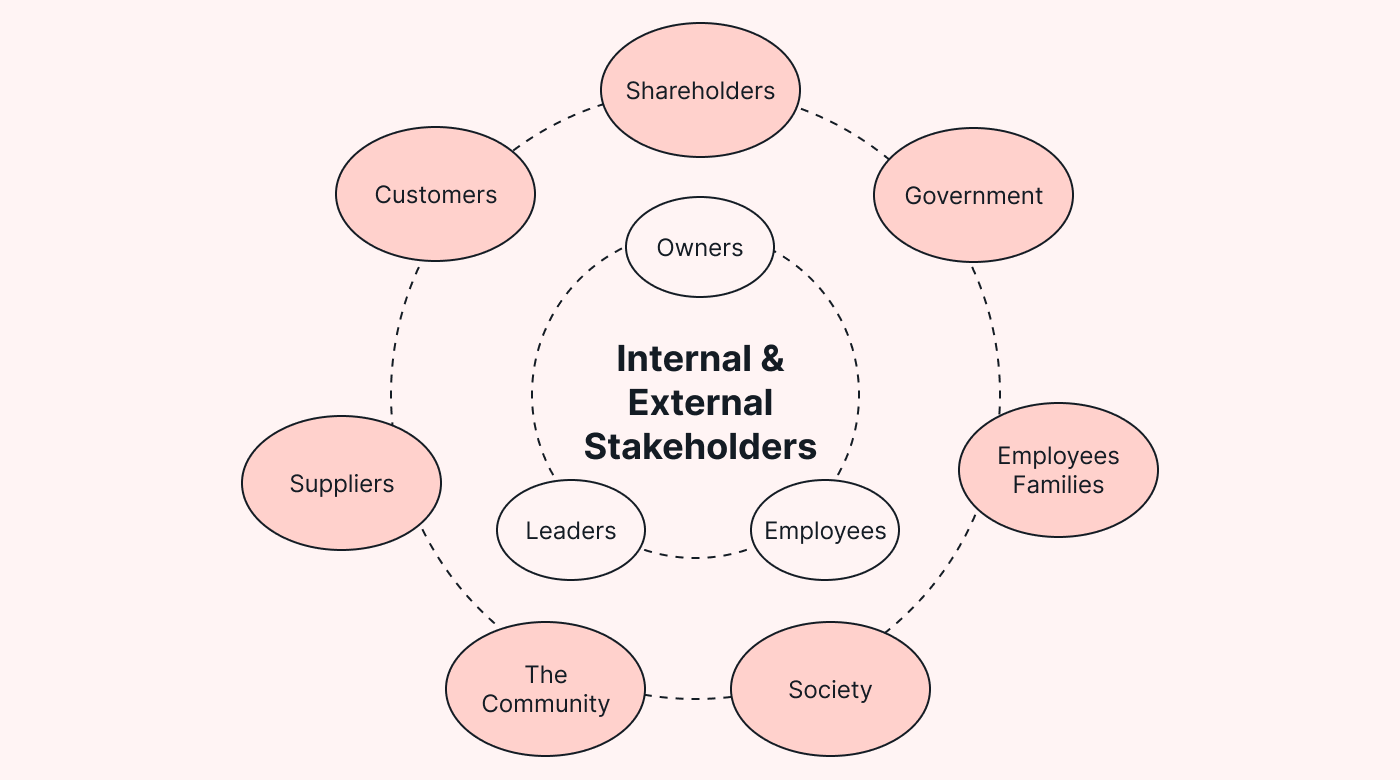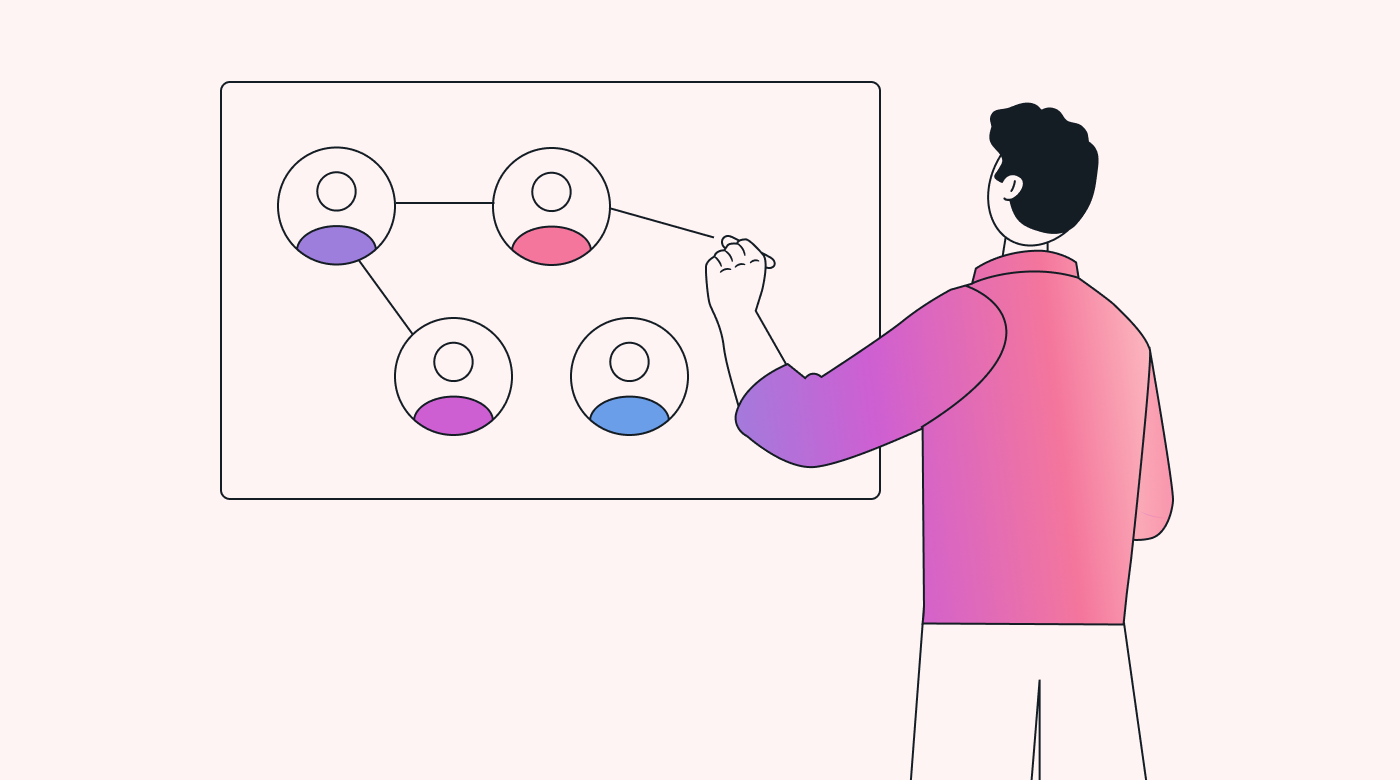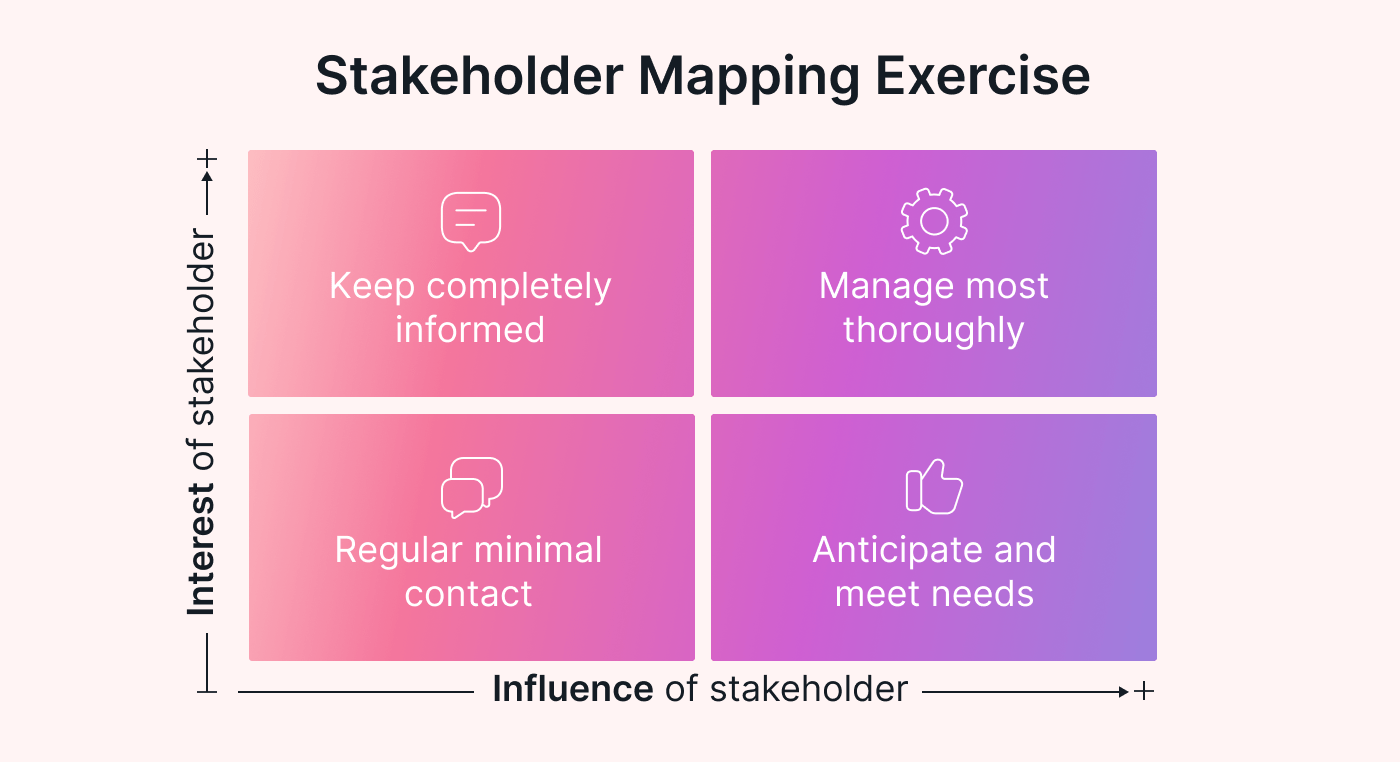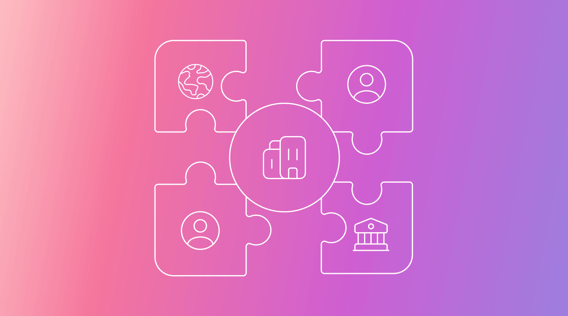No matter how small, any project or business activity has interested parties that might not be directly involved in the project. In project speak, they're known as stakeholders. Even the personal projects we undertake involve key players who have some level of influence on the project. The stakeholder lists and their level of participation grow more significantly as we move from personal to business projects.
Small businesses sometimes fail because of stakeholder relationships, and not engaging relevant stakeholders may cost you their buy-in. Or they involve stakeholders when it’s too late to salvage the situation.
You can improve project performance with a thorough stakeholder analysis.
This article provides an overview of stakeholder analysis. We'll cover the following:
- Definition of stakeholder analysis
- Benefits of stakeholder analysis,
- Types of stakeholders
- Simple steps for conducting stakeholder analysis
What is a stakeholder analysis?
The goal of a stakeholder analysis is to identify potential parties that may influence the outcome(s) of a project, and their level of influence on the project. With those in your back pocket, you can formulate a plan to manage and communicate with them.
But, first, let's define who a stakeholder is.
Who is a stakeholder?
A stakeholder is any party with an inherent interest in a business activity or project (and vice versa), and, most importantly, they can impact business or project outcomes.
Let's take the example of investors building a factory in your area. This, obviously, can have implications for many potential stakeholders. The most concerned may be the immediate community living around the proposed site.
Now suppose the new factory is a leather tanning facility.
That community living around the factory probably wouldn't be the biggest fans. At the top of their list of concerns would be the (possible) air and water pollution from the factory.
Other stakeholders would include local and state governments. Their support is critical as they can grant (or deny) business permits.
You can see how important stakeholders can be to businesses or projects. But, before we dive deeper, let's clarify the difference between stakeholders and shareholders.
Types of stakeholders
Not all stakeholders are the same. They differ in their influence over project success. Businesses and projects also impact stakeholders differently. There are two main types of stakeholders: internal and external. Let's review them in more detail.
 |
Internal stakeholders
An internal stakeholder is any party whose interests stem directly from a business. They make decisions that affect business outcomes. Internal stakeholders may be classified into primary and secondary stakeholders. However, not all secondary stakeholders are internal stakeholders.
Primary stakeholders are business owners, managers, and employees. They have a vested interest in the day-to-day operations of a business or project.
In contrast, secondary stakeholders aren't involved in the day-to-day workings of a business or project. An example would be project sponsors, whose contribution to the business or project may give them a 'seat at the table,' but they won't make daily decisions.
External stakeholders
An external stakeholder is any interested party outside of a business or project (a.k.a. tertiary stakeholders) but is affected (positively or negatively) by the business or project.
Examples include government entities, regulatory bodies, and surrounding communities.
Although they don't usually have direct influence over a business or project, it's essential to recognize this group.
Difference between a stakeholder and a shareholder
It's easy to confuse stakeholders for shareholders. The truth is that a shareholder can be a stakeholder and vice versa. But these two terms have entirely different meanings.
As we have already reviewed, a stakeholder is any party that influences outcomes and can be affected by the business or project outcomes.
A shareholder, on the other hand, is any party with a financial stake in a business or project.
Back to the leather tanning factory. The shareholders are those who have contributed the capital to build the plant. They're shareholders because they 'own a share' of the company. Shareholders receive profits or suffer financial losses depending on a company's performance.
Stakeholders may or may not suffer losses. This depends on whether they double as shareholders. For example, the community living around the proposed site doesn't expect profits.
Benefits of stakeholder analysis
In addition to being the foundation of a stakeholder management plan, doing a stakeholder analysis has a few other significant benefits.
 |
Ensuring stakeholder buy-in
As a business, you should secure stakeholder buy-in at the earliest possible opportunity. However, you must understand your stakeholders, including their expectations and needs, and approach each stakeholder in the way that best resonates with them.
Take the example of a tanning factory. You'd have separate approaches for the local community vs. the regulatory agencies.
For the community, you may need to communicate how the factory will benefit them and address their pollution concerns. You'd do these at community events or by taking out ads in the local newspapers.
For regulatory agencies, on the other hand, you might need detailed waste and risk management plans, communicated through official channels (e.g., filings done through legal channels).
Managing risks
Risks are inherent to any business, and managing them is critical for the survival of your business.
It's good practice to have a risk management plan, where you've identified possible risks and mitigations in case those risks become reality (issues).
Combine the risk management plan with your stakeholder analysis, and you have a powerful toolset to help you navigate risks and issues with your stakeholders.
For example, say, a local environmental agency changes regulations for waste management. This poses a compliance and regulatory risk for your business. The best way to mitigate this risk before it becomes an issue is by engaging relevant stakeholders (regulatory bodies).
Managing stakeholder expectations
Given their impact, you must manage stakeholder expectations throughout the entire lifecycle of a business or project. But, first, you have to understand the stakeholder and their expectations. That's where the stakeholder analysis comes in.
For example, a stakeholder analysis might indicate that the community around the tanning factory is concerned about pollution. Knowing this, the owners could plan a long-term communication strategy, including ads in local newspapers, to assure the community that they'll have pollution mitigation measures in place.
Improve brand recognition (and trust)
The key idea behind a stakeholder analysis is to gauge their expectations (including expected outcomes) of, and impact on your business or project. With those in your pocket, you can tailor your brand's messaging and communication to each stakeholder group.
Again, take the tanning factory. Stakeholders include customers and the local community. Note that these are two separate stakeholder groups, each with their own expectations and impact, although they can overlap. The owners can appeal to these stakeholders in several ways, including purchase order transparency for the customers and community programs for the community. The great thing is that these aren't competing communications.
4 simple steps to a stakeholder analysis
Here are four simple steps to doing a stakeholder analysis.
Identify the stakeholders
The first step is identifying all parties affected by a project or business activity. Project stakeholders may be different from business stakeholders.
Suppose you are a small PR agency implementing a new PR campaign for a local government agency. Your project stakeholders will include parties that are directly involved
- Project manager
- Development team
- Project sponsor
- End-users
- Knowledge-area specialists
Then there are the business stakeholders: managers, the board of directors, and employees who aren't directly involved in the project.
Determine stakeholder expectations
A major reason for classifying stakeholders is to understand their expectations and influence. This allows you to manage each stakeholder more effectively.
Here are some questions to ponder:
- What exactly are the stakeholders' expectations?
- How much influence does this stakeholder have over project or business outcomes?
- What would happen if we didn't meet their expectations?
Using the example of a tanning factory, you may identify several stakeholders, including the local community, customers, employees, and regulatory agencies. These stakeholders have different expectations and influence business outcomes to different extremes. For example, not meeting the regulatory body’s expectations may mean having your licenses revoked and the plant shut down. This makes the regulatory body an important stakeholder that should be managed closely.
The local community, on the other hand, is also an important stakeholder group, but it influences business outcomes less than the regulatory agencies.
 |
Rank and classify the stakeholders
The next step is to rank and classify the stakeholders you identified in step one using a four-quadrant stakeholder analysis matrix.
Classify your stakeholders based on their proximity to and influence on the business or project.
The most important stakeholders are those with the highest interest and influence. These stakeholders should be closely managed. Stakeholders with high interest but limited influence should also be managed regularly.
Other stakeholders, like regulatory bodies, aren't interested in outcomes but are very interested in what you're doing. You should anticipate and address their concerns as they come up.
The last group consists of stakeholders who might have little interest or influence. An example is the community within which your business is operating. Companies can use general communication channels to keep this group updated.
Manage stakeholder expectations
Based on the information and ranking, you should prepare a management (and communication) plan for each stakeholder.
Effective stakeholder management includes setting realistic expectations for project timelines, tasks, and outcomes and engaging stakeholders to make sure they understand these pieces. Doing so will make it easier to explain and manage expectations when things like scheduling, cost, or delivery dates change.
For example, you should communicate to your customers (a stakeholder group) whenever there are disruptions in production because they may mean short-term product shortages or delays in delivery. Stakeholders appreciate when they receive timely communication.
4 tips for better stakeholder analysis
Here are four tips to make the most out of your stakeholder analysis.
Be inclusive
You should account for, and tailor your stakeholder analysis for stakeholders' diversity.
How you interact with government entities is probably different from how you interact with the local community.
Also, consider cultural and social factors when engaging stakeholders. For example, Muslims have a strong stand against pork products. This means a business involved in processing pork products may not approach the Muslim community as they would other groups.
Be transparent
You should be honest with your stakeholders throughout the entire business or project lifecycle.
A stakeholder may support the project during the initiation stage only to jump ship when they discover new information.
The best way to navigate this is by being upfront with stakeholders. You should anticipate and highlight issues as soon as possible and then outline how you'll address them.
For example, the leather-tanning business may outline its plans to treat wastewater should toxins be accidentally released into the local water supply.
Communicate, communicate, communicate
Communication is the key to successful collaboration. This is precisely what you want to do with your stakeholders. And it starts at the beginning when you're looking for stakeholder buy-in.
Then, you must maintain open communication channels throughout the project or business life cycle. The level of engagement depends on the stakeholder group and their influence on outcomes.
Stakeholders like employees and shareholders require regular updates. In contrast, the local community might only need communications on matters of public interest.
Suppose the tanning factory plans to overhaul its management information system. You'd update employees, shareholders, and suppliers because this impacts how you work with them daily, but not so much the community at large.
Boost your project's success through effective stakeholder analysis
Stakeholder analysis is integral to running a successful business or project. Overlooking your stakeholders is, pardon the pun, risky business.
Once you've completed your stakeholders analysis, you can leverage Motion to centralize stakeholder information and documents like stakeholder maps and communicate (and collaborate) with your stakeholders, all within the app.
You can also automatically schedule meetings and reviews using Motion's AI-powered calendar manager.
Try Motion's free trial today!





